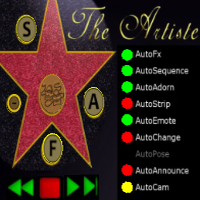I also wanted to video-document some of the procedures in detail while they were fresh in my mind. This is the 1st suite component to have video instructions to go along with the instruction book, so I am now learning and experimenting with how-to-videos.
====================
Creating a ChildRezzer
The very 1st clip in the first video is a clip of how to create a Linkset-based ChildRezzer. This is at the core of preparing the rezzer. The good news is that if you can link all your objects into one linkset and that linkset is copy/mod, then this clip is all you need to build and have your set rez-ready for your show. Done.
Multiple Sets and Invisibility
Multiple Sets and Invisibility
The 1st video highlights the ability to work with multiple sets at the same time. Seems like a simple thing and it is, sort of. But to me its huge because the rezzers I had bought always delete the current rezzed set of objects before rezzing a new set. I suppose if you needed to work with multiple sets at the same time, i.e. aligning, you could use multiple commercial rezzers, but when using my rezzer, the cross-fading is built in so no extra scripts or setup-time needed.
Also, the Artiste set-rezzer is Palette-aware meaning that it won't step on the shared area that both rezzers and devices like 'movers' use. Both use the object-description area to store information and so unless you are the creator the rezzer and the mover, you won't be able to include movers as part of your rezzable object-set and will have to manually place the movers at showtime.
As you will see, there are a lot of auxiliary features and abilities, that one would not initially think of, that are included.
Invisibility
Making a set invisible and rezzing it can avoid broadcasting to the audience what your set is about as parts if it often poke thru the curtain. You can also avoid where huge pieces of sets chop off the heads of the audience during their rezz cycle.
Invisibility is also a critical component in setting up cross-fades, so it is a valuable skill.
Disappearing and Failing Alphas
It is a well known fact, as admitted by some official techies, that there are problems with alphas not reappearing after going invisible in certain circumstances. I worked about 2 frustrating weeks on a work-around and finally, with the help of another scripter and some adjustments on my own, I was able to devise a schema that avoids this ugly pitfall. So I have created special parameters on a note-card to address this issue. They default to something I have found that works, but you may find yourself able to adjust them down to reduce the added overhead in seconds and pre-processing during that I have been taxed with during the rezz cycle. The good news is that rezzing is not time-critical, nor does it need to be visible since all in-show initial rezzing should be invisible in almost all cases.
========================================
Non-Permissive Objects
Non-Permissive Objects
The 2nd video demonstrates how we have adapted our set-rezzer to accept no-copy and no-modify objects and link-sets. The idea is to not have to worry about the placement of any objects during the rezzing of a set. The processes are well documented, demonstrated, and flexible. I don't know of any rezzer that lets you process no-modify objects. I am crazy enough to offer a solution though not without a bit of manual intervention in the cleanup process. It beats what we have now and offers a total manual-free-operation during the critical set-setup period at a price of some pre-preparation resources.
========================================
Cross-Fading
Set Cross-Fading is a popular method for transitioning from one set to another. Here I demonstrate manual and automatic (HUD-based) cross-fading. Because our Palettes can be configured as Particle emitters and because our set-transitioning is syncable via the Artiste Performance HUD, you could also mask a set-change using Particles.

No comments:
Post a Comment